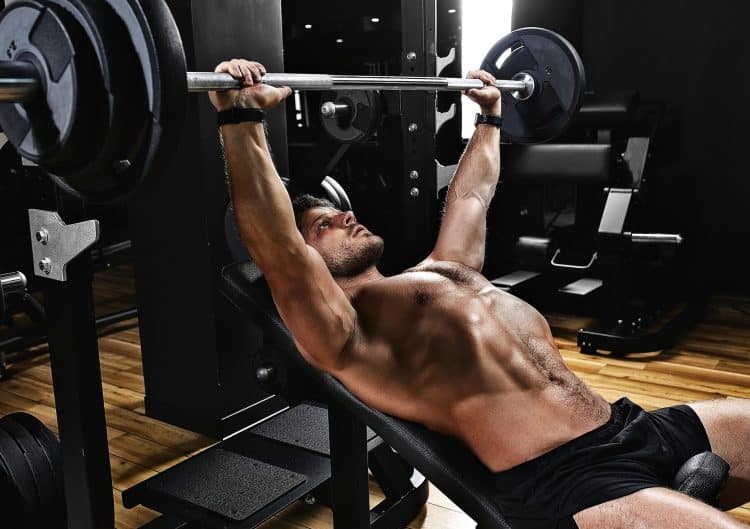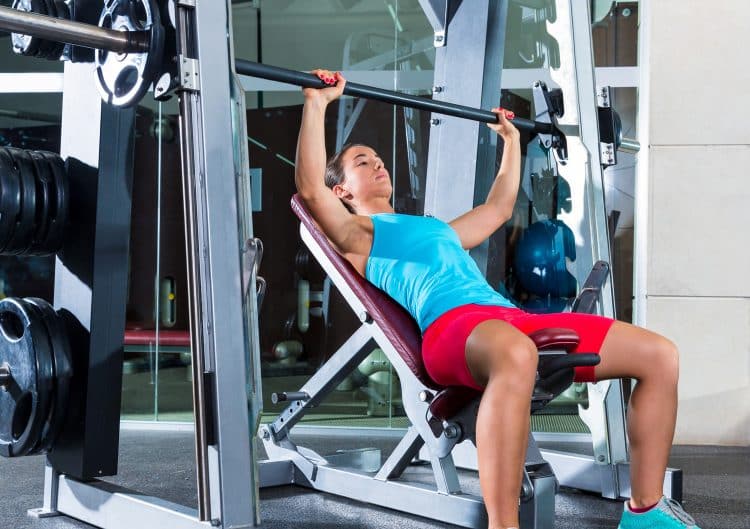The upper chest is a lagging muscle group for most people. Plus, it is one of the most stubborn. And on top of this, many lifters make matters worse by not training their upper pecs adequately.
While the barbell bench press is a great compound (multi-joint) exercise to build pectoral muscle mass and strength, it does little to nothing for the upper pecs. Furthermore, the upper chest is usually the last pectoral muscle to respond to training, meaning your upper chest will probably show improvements in size and conditioning after your middle and lower pecs.
How do you know if you have a weak upper chest?
A muscular upper chest improves the separation between your upper chest and neck, traps, and shoulders.
On average, lifters are weaker on the incline bench press than on the flat and decline versions of the exercise, compounding the strength and muscle imbalances.
In this article, you’ll learn about the average incline bench press by gender, weight, and experience level, how to perform the incline bench press with the correct form, and get better at the lift.
Average Incline Bench Press By Weight, Experience Level, and Gender
The numbers below represent the one-rep max (1RM) and as confirmed by our average bench press guide, lifters, on average, are weaker on the incline bench press than on the flat or decline bench press. So, if you’ve never performed the incline bench press before, you shouldn’t load the bar with the same weight you use on the flat barbell bench press.
Level Up Your Fitness: Join our 💪 strong community in Fitness Volt Newsletter. Get daily inspiration, expert-backed workouts, nutrition tips, the latest in strength sports, and the support you need to reach your goals. Subscribe for free!
The tables below will help you find how you stack up against lifters at your level. You shouldn’t try matching the number in your relevant column as soon as you step inside the gym. Take your time warming up and make sure you have a trustworthy spotter before you attempt your 1RM.
But why are most lifters weaker on the incline bench press than on the flat barbell bench press, you ask?
Experts believe that the incline bench requires greater shoulder strength, which makes it more difficult. Plus, it is harder to maintain balance and follow the correct movement pattern on the incline barbell bench press than on the flat bench press.
On a lighter note, the incline bench press might see broader adoption in gyms worldwide if bros change their customary “how much do you bench?” to “how much do you incline bench?”
Related: Gym Bro Test: Find Out If You Are The Next BroScienceLife
How much can the average man incline bench press?
For an individual, the average incline bench press depends on factors like weight, experience level, gender, and age.
Below is the Male Incline Bench Press Standards chart from Symmetric Strength:
| Body weight (pounds) | Untrained | Novice | Intermediate | Proficient | Advanced | Exceptional | Elite | World Class |
| 114 | 55 | 85 | 115 | 140 | 165 | 190 | 215 | 235 |
| 123 | 60 | 90 | 120 | 155 | 180 | 205 | 230 | 255 |
| 132 | 65 | 100 | 130 | 165 | 190 | 220 | 245 | 275 |
| 148 | 70 | 110 | 145 | 180 | 210 | 240 | 270 | 300 |
| 165 | 80 | 120 | 155 | 195 | 230 | 260 | 295 | 325 |
| 181 | 85 | 125 | 165 | 210 | 245 | 280 | 310 | 345 |
| 198 | 90 | 130 | 175 | 220 | 255 | 290 | 330 | 365 |
| 220 | 90 | 140 | 185 | 230 | 270 | 305 | 345 | 385 |
| 242 | 95 | 145 | 190 | 240 | 275 | 315 | 355 | 395 |
| 275 | 100 | 145 | 195 | 245 | 285 | 325 | 370 | 410 |
| 319 | 100 | 150 | 200 | 250 | 295 | 335 | 375 | 420 |
Per the data, an advanced or exceptional male athlete can, on average, lift thrice as much weight on the incline bench press as an individual who doesn’t lift. At the same time, world-class athletes can lift more than twice as much as intermediate lifters.
The amount of weight an individual can lift increases linearly across bodyweight and experience levels. However, the difference between the average incline bench press and flat barbell bench press is notable.
While a 275-pound world-class athlete can perform a flat barbell bench press 1RM with 500 pounds, he maxes out on 410 pounds on the incline barbell bench press. On the other hand, a 148-pound world-class lifter, on average, can lift 365 pounds on the flat barbell bench press but hits the ceiling on 300 pounds on the incline bench press.
How much can the average woman incline bench press?
Like men, the average incline bench press for women depends on factors like age, weight, and experience level.
Below is the Female Incline Barbell Bench Press Standards chart from Symmetric Strength:
| Body weight (pounds) | Untrained | Novice | Intermediate | Proficient | Advanced | Exceptional | Elite | World Class |
| 97 | 35 | 55 | 75 | 90 | 105 | 120 | 135 | 150 |
| 105 | 40 | 60 | 75 | 95 | 110 | 130 | 145 | 160 |
| 114 | 40 | 60 | 80 | 100 | 120 | 135 | 155 | 170 |
| 123 | 45 | 65 | 85 | 110 | 125 | 145 | 165 | 180 |
| 132 | 45 | 70 | 90 | 115 | 135 | 155 | 170 | 190 |
| 148 | 50 | 75 | 100 | 125 | 145 | 165 | 190 | 210 |
| 165 | 55 | 80 | 110 | 135 | 155 | 180 | 200 | 225 |
| 181 | 55 | 85 | 115 | 140 | 165 | 190 | 215 | 235 |
| 198 | 60 | 90 | 120 | 150 | 175 | 200 | 220 | 245 |
Since the incline bench press requires greater shoulder recruitment than the flat barbell bench press, it is not the strongest lift for women.
Although females at the lighter end of the spectrum start strong on the incline barbell bench press, their strength, on average, stagnates soon and does not increase incrementally as their male counterparts.
The divergence between the strength of an average female on the incline bench press and flat barbell bench press widens with an increase in body weight. While an average 198-pound world-class female athlete can crush 445 pounds on the flat barbell bench press, she hits the rut at 245 pounds on the incline bench press.
Level Up Your Fitness: Join our 💪 strong community in Fitness Volt Newsletter. Get daily inspiration, expert-backed workouts, nutrition tips, the latest in strength sports, and the support you need to reach your goals. Subscribe for free!
On the other hand, a 123-pound world-class female athlete can, on average, lift 310 pounds, whereas she plateaus at 180 pounds on the incline bench press.
Related: Flat Bench vs. Incline Bench Press – Which one should you do?
Overall Average Incline Bench Press for Males and Females
Here are the overall incline bench press figure for both men and women:
Overall Average Incline Bench Press for Men
Per the Centers for Disease Control and Prevention’s National Center for Health Statistics (CDC), an average American male weighs 197.8 pounds, meaning the average incline bench press of a man that doesn’t lift is 90 pounds or 130 pounds for a rookie lifter.
Furthermore, the average incline bench press jumps to 175 pounds for an intermediate lifter, 220 for a proficient, 255 for an advanced, 290 for an exceptional, 330 for an elite, and 365 pounds for a world-class athlete. [1]
Overall Average Incline Bench Press for Women
An average American female tips the scales at 170.5 pounds. Per the stats from Symmetric Strength, a 165-pound woman (closest to 170.5 pounds) with no lifting experience can, on average, incline bench press 55 pounds or 80 for a novice.
The number leaps to 110 pounds for an intermediate lifter, 135 for proficient, 155 for advanced, 180 for exceptional, 200 for elite, and 225 pounds for a world-class athlete.
Calculate Your 1RM (One-Rep Max)
Hitting one-rep maxes is no joke, and you shouldn’t trail your training partner or use the trial and error method to determine your 1RM unless you’re trying to get injured—that is.
The good news is, with the advancement in exercise science, we have calculators that can help you find your 1RM for different exercises based on your current strength levels. Plus, they leave enough wiggle room to ensure you’re in total control as you go for your personal record (PR).
Confused about which one-rep max (1RM) calculator is right for you? We’ve got you covered. Check out our convenient bench press calculator to discover your one-rep max using different methods.
How to Incline Bench Press
- Target Muscle Group: Chest
- Type: Hypertrophy, strength
- Mechanics: Compound
- Equipment: Barbell
- Difficulty: Beginner to Advanced
- Secondary Muscles: Shoulders and Triceps
- Best Rep Range Per Set: 10-15 (hypertrophy), 2-5 (strength)
Following the correct technique and form while performing an exercise can help you get the best bang for your buck, and it is no different with the incline bench press.
Here is how to perform the exercise:
- Lie on an incline bench with a slight arch in your back. Your upper back should be lifted slightly off the bench so there is enough space for your hand to pass between your back and the pad.
- Grab the barbell with an overhand wider-than shoulder-width grip.
- Pull back your shoulder blades and drive them into the bench.
- Brace your core and unrack the bar.
- At the starting position, your arms should be extended straight so they are perpendicular to the floor.
- Tuck in your chin as if holding an egg between your chin and upper chest.
- Take a deep breath and slowly lower the barbell by bending at your elbows until it touches your upper chest below your chin.
- Exhale sharply as you explode back to the starting position.
- Pause and contract your pecs at the top.
- Repeat for recommended reps.
Pro Tips:
- Drive your heels into the floor to generate extra force.
- Do not lock out your elbows at the top. Doing so will take tension off your pecs and place it on your arms.
- You might have to adjust your grip depending on how the movement hits your upper pecs. If you feel too much stress on your shoulders, try holding the bar with a wider grip.
- Aim for your sternum (breastbone) or slightly below as you lower the bar to your chest.
- Your wrists, elbows, and the bar should travel in a straight line. Letting your elbows drive forward can put unnecessary stress on them.
- Touch the bar to your upper pecs with every rep.
- Wrapping your thumbs around the bar can help generate more power. Only advanced lifters should use a monkey (suicide) grip as it increases the chances of injury.
Check out our complete barbell bench press guide here!
FAQs
If I perform the incline bench press in my workout, can I exclude the conventional barbell bench press?
The incline and flat barbell bench press train your pectoral muscles differently. Hence, both deserve a place in your exercise regimen. While the incline variation targets the upper pecs, the latter favors the middle chest.
What is the best rep range to build muscle mass while performing the incline bench press?
You should target achieving muscle hypertrophy by performing 10-15 reps of every set if your goal is to build muscle mass and conditioning. On the other hand, you should perform two to five reps per set if you’re training for strength.
Are the incline barbell bench press and incline dumbbell bench press the same?
No. While both exercises train the same muscle group, they have different movement patterns, training the muscles differently.
What is a good incline bench press for a male?
Depending on how you define ‘good’ and your age, weight, gender, and experience level, this is a subjective question. Please refer to the tables above to check how you stack against your peers.
You might also like:
- Average Bench Press By Age, Weight, Gender, and Experience Level
- Average Deadlift By Weight, Gender, and Experience Level
- Average Squat By Weight, Gender, and Experience Level
- Average Pull-Up and Chin-Up By Weight, Gender, and Experience Level
- Average Power Clean By Weight, Gender, and Experience Level
- Average Thigh Circumference in Males and Females
- Average Calf Size for Men and Women
- Average Waist Size For Women and Men
- Average Biceps Size: How Do You Measure Up?
Wrapping Up
The incline bench press can help improve your physique’s aesthetics by improving your chest musculature, symmetry, and balance; boost your chest and shoulder strength and size; improve your posture and muscle definition.
Working on improving your incline bench press will pay dividends in the long run. Remember, use the charts in this article as benchmarks, and do not bite off more than you can chew, as it can lead to injury. Follow the correct technique and rep range to make the most of this lift. Best of luck!
References
- McDowell MA, Fryar CD, Ogden CL, Flegal KM. Anthropometric reference data for children and adults: United States, 2003–2006. National health statistics reports; no 10. Hyattsville, MD: National Center for Health Statistics. 2008.












